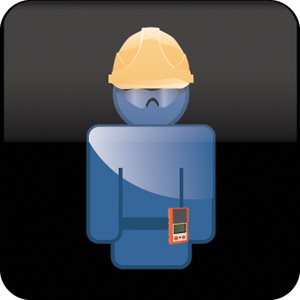Today, more data is available to us than ever before. This critical data can provide visibility into alarm events and unsafe behaviors. It can also be used to take corrective and preventive action to save lives. With all of the available data and technology, why are men and women still losing their lives to gas-related incidents?
It’s simply not enough to arm every worker in hazardous environments with a gas detector. Even the most reliable monitor cannot keep workers truly safe in the field if it is improperly used or poorly maintained. Successful gas detection programs include the following: reliable equipment, safe behavior and painless

|
service. Here’s why these three components of any gas detection program are critical to increasing the safety of your workplace and building a stronger program to save lives.
1. Reliable equipment: Do your gas detectors work properly?
Every worker needs robust, reliable gas detectors and docking stations to keep them safe in hazardous environments. In order for workers to ensure reliability and have confidence in their equipment, they must know that it is in proper working condition. The most important elements of gas detector maintenance are function (“bump”) testing and calibration. Function (“bump”) testing involves applying a brief exposure of a gas concentration greater than the instrument alarm set points to the gas sensors and verifying that the sensors and alarms function properly.
Calibration, on the other hand, confirms the accuracy of the sensor readings and provides insight into the condition of the sensors. Regular execution of both of these functions will provide confidence that your gas detectors are working properly. Remember, the only way to be assured that your gas detector will respond properly when encountering a life threatening gas concentration is to test it with a known concentration of gas. Technology has provided automated systems to perform these functions
and maintain this critical and life-saving data.
2. Safe behavior: Are your gas detectors being used properly?
Gas detectors are completely ineffective if used improperly. Visibility into alarm events and unsafe behaviors provides teams the data needed to take the corrective and preventive actions that keep them safe. In an organization with a weak safety culture or poor processes, workers may not always use their gas detectors properly. The following are some examples of unsafe behaviors that you should look for to know if your gas detectors are being used properly.
Using gas detectors without calibrating or bump testing: Do you know if your workers tested their gas detectors before the start of their shift? Data collected from more than 27,000 gas detectors in a 2009 study conducted by Dr. Raghu Arunachalam, Ph.D., who is the director of emerging technologies at Industrial Scientific, showed that three in every 1,000 detectors used on a daily basis are likely to fail a bump test and subsequently fail to respond to gas if encountered during use. As noted above, detectors must be tested with a known concentration of gas to ensure proper working condition. Don’t let your workers use an instrument without testing it first.
Ignoring alarms / Turning off a gas detector in alarm / Not using gas detectors: Gas detection is only one part of a workers’ daily activity. Today’s industrial workers are faced with many duties and responsibilities and are ultimately held accountable for getting the job done under extremely tight deadlines. Dr. Arunachalam’s gas detector study, now containing data from more than 47,000 gas detectors, has confirmed that gas detectors go into high alarm once every 10 days. In 0.26 percent of those alarm incidents, users have turned the detector off while in alarm condition. Dr. Arunachalam’s gas detector study also showed that the average utilization rate of multi-gas detectors on a daily basis is 15 percent. As strange and surprisingly low as this may seem, investigations of gas-related fatal accidents often find workers not using their gas detectors at all or find them with the victim having never been turned on.
3. Painless Service: Do you have a means of cost-effective, timely and painless service?
Gas detection isn’t core to most businesses, yet it requires significant time and money as instruments require regular maintenance and repairs. Cost-effective, timely and painless service is required to keep instruments in proper working condition and ready to protect. A gas monitor is a complex system that includes a sensor surrounded by sensitive electronics, alarms, a battery and a display and is called on regularly to save lives. It is critical that your program includes cost-effective, timely
and painless servicing.

|
A recent and growing trend for gas detection users has been outsourcing. In today’s world in which workers and teams are expected to keep doing more with fewer people, outsourcing gas detection makes sense.
There are two critical components an outsourced gas detection program must contain in order to be effective. First, a system must be available to automate and schedule time-consuming maintenance tasks such as function (“bump”) testing, calibration and battery charging required for the proper operation of your gas detector fleet. This automation allows your team to be more productive and focused on their core business and revenue-generating activities. Second, you must have a gas detection data management system that organizes and presents your data in a manner that provides visibility into your gas detection program at a glance. The system should alert you when problems occur and allow you to quickly access the data to identify the root cause of the issue. Keep in mind that in order for your gas detection program and processes to improve, you must use the data available to you. A good gas detector data management system should provide full insight into the condition and proper use of your equipment and all gas hazards to which your team is exposed.
Is your gas detection program effective?
It is worth repeating that it’s simply not enough to arm every worker in hazardous environments with a gas detector. The reality is that workers will continue to lose their lives to gas-related accidents until we realize and act upon the fact that even the most reliable monitor cannot keep a worker safe if it is improperly used or poorly maintained. Successful gas detection programs include reliable equipment, safe behavior and painless service…do you have them covered?

